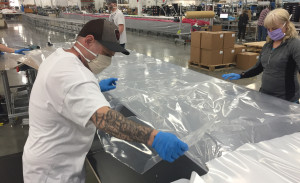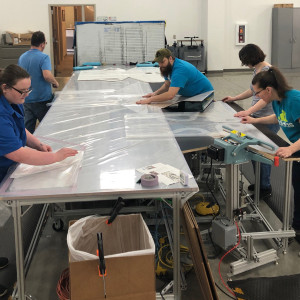Shortly after getting a question from his director, Brad Jensen ’93 said he needed some time to think about the latest request. A local health care organization had contacted Raven Industries to see if it could create personal protective equipment for its fight against the COVID-19 pandemic.
After about 90 minutes, Jensen, the manufacturing engineering manager at Raven’s Aerostar Division, had an idea. After seeing several samples, he was reassured he was on the right track. Using film produced by Raven Engineered Films, Jensen and others created a prototype that afternoon. That example was tweaked after client feedback, and a design was established after the second day. The product was then added to Raven’s manufacturing cycle, and 600 gowns were made in two days.
“They were happy with the product and said they’d take whatever we can make,†Jensen said. “At first, the thought process was we’d make 3,500 to 4,000 a week. However, it really exploded from there. From that initial thought, we’re talking pretty wild numbers, like 10s of thousands every week; it’s a real an eye-opener for us.â€
Lisa McElrath ’10, Raven Industries’ communications manager, said people throughout the company were excited at the opportunity and chance to make a difference in this pandemic.
 “Raven is an organization that thrives on innovation and rising to the challenge. When the Raven Aerostar team received this request, we immediately knew they could make a difference.
“Raven is an organization that thrives on innovation and rising to the challenge. When the Raven Aerostar team received this request, we immediately knew they could make a difference.
We’re incredibly proud of how quickly they made this a priority in order to help protect and support health care workers during this time.â€
Since the original call, other health care organizations have contacted Raven about PPE gowns.
“We fully realize they’re talking about the pandemic going on for several months. While that’s a long time for others, that’s a short-term product in the manufacturing world,†Jensen said. “Our production capacity is driven by a few defining pieces of equipment. But we do look to produce 10s of thousands in the coming weeks and months.â€
Jensen and McElrath said it was a collaborative effort to develop and produce the PPE gowns. In addition to other departments providing ideas and manhours, Cole Langer ’18 helped build manufacturing tables and various modifications.
“It took a lot of us from engineering to get our hands dirty and try to come up with the best solution,†Langer said.
“Yes, it was a challenge,†Jensen said. “Both Cole and I were here last Saturday (March 28) building equipment and testing how we were going to do the manufacturing over the weekend. We all were pretty busy the next Monday and Tuesday, but at some point, Cole had to cut away and run our usual business. The first-day push helped set expectations and define what people needed to do. That made it easier, and we had people who could fill in what Cole had done after the first couple of days.â€
“Everyone feels incredibly good about doing this type of work,†Jensen said. “It’s one of the things that’s a worldwide emergency, but we’re helping locally. It’s a morale booster with everything else that’s going on in the world.â€
 Langer, who has been at Raven for nearly two years after earning his B.S. in mechanical engineering, said he did not have much experience in this area but was willing to do whatever it took.
Langer, who has been at Raven for nearly two years after earning his B.S. in mechanical engineering, said he did not have much experience in this area but was willing to do whatever it took.
“I never imagined working on something like this, something with the potential to help a ton of people,†he said. “I’m super happy our company was able to do something to help out with this pandemic.â€
Jensen, who also earned a B.S. in mechanical engineering, has been in manufacturing for 25 years. That experience helped him run scenarios through his head to assess the benefits of doing things different ways to create the highest probability of success.
“It turns out there were only a few ways to manufacture the gown so that defined the scope significantly,†Jensen said. “Once we had the guiding idea, we were going at a fast enough pace, and I could say ‘Cole, I need something that looks like this and does this,’ and get something that works. While there was not time for a full engineering design, we had to document everything on the prototype to get someone else to reproduce when that time came.â€
While Raven was starting to produce the PPE gowns, it was already looking for production efficiencies. In his work to optimize cutting floor efficiencies, Pat Thies ’86 helped take the manufacturing operation from a small crew working day shifts on a low-volume specialty product, to a two-shift mass production line running with much larger crews of team members. A senior design engineer, Thies optimized equipment for material handling, waste and scrap removal, and overall production line layout improvements for volume efficiency.
“Because of that big push made early on in the week, we’ve started to wind down the engineering side of it,†Jensen said. “We ran the numbers to know what we’d need for materials
and ordered parts and assemblies so we’re ahead of the game. The first days of ramping up production were busy, but since we have been producing high quantities, we’ve made more than 110,000 gowns.â€
– Matt Schmidt






